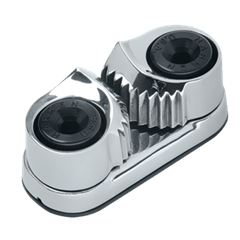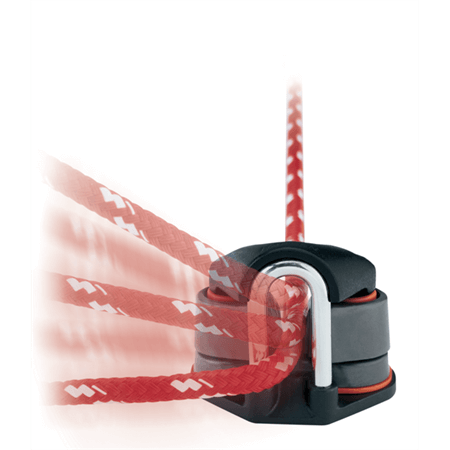How to choose the right cam cleat
Have you ever really thought about how important the cam cleat is on your boat? I never gave them much thought until I was out sailing on an old Pearson 21 and the cam cleat for the mainsheet and starboard jib sheet were broken. Sailing that day made me appreciate what I used to always take for granted.
With different brands and all the different options from fairleads, to swivels to quick releases, where do you start?
Choose for line size
|
Cam Cleat |
Line Size – Imperial |
Line Size - Metric |
| Small or Micro Cleat | 3/32 – 5/16in | 2 – 8mm |
| Medium or Standard Cam | 1/8 – 1/2in | 3 – 12mm |
| Large or Offshore | 1/4 - 5/8in | 6 – 16mm |
If you are using a line that is at the upper range of the cleat, I recommend using the next size up. This seems to allow for easier cleating and uncleating.
Cleat Brand – Keep it Consistent
The first place I start when looking at replacing or adding cam cleats to my boat is consistency. Is your boat currently all Harken or Ronstan camcleats? If so, I like to stick with that brand. They have bearings and springs in them, and these parts occasionally break. By sticking with a single brand, you need to keep fewer replacement parts on hand.
Brand Comparison
Harken:
Materials: Harken makes cam cleats in 3 different materials - Aluminum, Stainless Steel or Plastic reinforced with Carbon Fiber.
- Aluminum: The Cam-Matics are probably the most widely used cam cleats in the world. The aluminum tends to last longer. The teeth also seem to be easier on line than the carbo cleats.

-
Stainless steel: These cleats are only available in the largest size - Offshore. The big
selling point for these is the look, if you are running nice stainless steel winches, these will look great next to them. Otherwise, I would look elsewhere, because these are twice the price of other cam cleats and don't offer any performance advantage.
- Carbon reinforced plastic: The carbo cams big selling point is weight. They have slightly less max working load than the aluminum cam-matics, but weigh over an ounce less. So if weight is critical and you aren't as concerned about wear on your lines, these are the best choice for you.
Bearing Design - All Harken cam cleats use ball bearings. These are delrin bearings that work extremely well. The downside to ball bearings is that if you disassemble them incorrectly they will go everywhere and 66 ball bearings rolling around is never fun. On the plus side, Harken has widely available rebuild kits, so if your cleat does break, you can easily repair it.
Ronstan:
Materials - Ronstan only makes cleats out of reinforced plastics. They have a line of carbon reinforced cams as well as a line of fiberglass reinforced cams.
- Carbon Reinforced - These are lightweight, well designed for most uses. They are slightly heavier than the comparable Harken cleats - 50g vs 44g
- Glass Reinforced - We don't find any reason to use these cleats over the carbon cleats. They are priced the same for older technology, which is why we don't even carry them.
Bearing Design - Ronstan uses a solid acetal sheave for the bearing. This is nice, because if you need to take apart the cam cleat, it stays together. That being said, we are not sure on the longer term life of this bearing.
Accessories
The final thing you will need to choose for your cam cleat is the accessories. Both Ronstan and Harken have a variety of accessories to increase the practicality and use of the cleats. The accessories pretty much break down into 1: Fairleads 2: Bases.
Cam Cleat Fairleads

Standard fairleads - These keep the line captive so when you release the line from the cleat it doesn't go anywhere. These are extremely common. We use a cam cleat with a
fairlead for the WindRider 17 jib sheets. We don't want the line coming too far out of the cleat. However, for the mainsheet, since the cleat is on the side of the boat, a fairlead would be too restrictive, we don't use one on that cleat. So, if you want the line captive in the cleat and don't need to be moving the position of the line side to side, this is a good item. They are usually also colored, so you can color code your cleats for easier use.
Specialty fairleads - These, such as the x-treme angle fairlead or this fast release fairlead provide a specific role that can make
cleating/uncleating easier. The Xtreme angle fairlead are for cleats in which you will need to cleat, but because of positioning can't easily center the line. This keeps the line centered between the cams and allows you to cleat even when up to 90degrees from the cleat. The fast release fairleads keep the line captive, but are specially designed to help keep the line from recleating. This is good for when you are needing to do quick maneuvers.
Cam Cleat Bases

-
Risers and Angle Bases - These help position the cleat for better line entrance. Look at
how you are going to mount the cleat and if you need it to sit up higher, or sit an angle, these risers and angle bases give you more options.
- Swivel Bases - Swivel bases come in a number of different varieties. For smaller boats the swivel bases just use a nylon fairlead to guide the line and don't have any sort of bearings to help them swivel better. The Harken 240 and Ronstan RF67 are examples of these. For larger boats, where the loads are higher, the bases have mounts for blocks, taller arms and ball bearings so they swivel better. Please note that these don't come with blocks, so you would need to add a block in addition to the cleat base.
